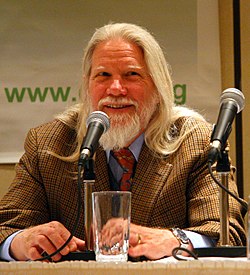Whitfield Diffie
| Whitfield Diffie | |
|---|---|

Whitfield Diffie in 2007
|
|
| Born | Bailey Whitfield Diffie June 5, 1944 Washington, D.C., United States |
| Nationality | United States |
| Fields | Cryptography |
| Institutions | Stanford University AI lab |
| Alma mater | Massachusetts Institute of Technology (B.S., 1965) |
| Known for | Diffie–Hellman key exchange |
| Notable awards |
Kanellakis Award (1996) Marconi Prize (2000) Hamming Medal (2010) Computer History Museum Fellow (2011) Turing Award (2015) |
Bailey Whitfield 'Whit' Diffie (born June 5, 1944) is an American cryptographer and one of the pioneers of public-key cryptography.
Diffie and Martin Hellman's paper "New Directions in Cryptography" was published in 1976. It introduced a radically new method of distributing cryptographic keys, that went far toward solving one of the fundamental problems of cryptography, key distribution. It has become known as Diffie–Hellman key exchange. The article also seems to have stimulated the almost immediate public development of a new class of encryption algorithms, the asymmetric key algorithms.
After a long career at Sun Microsystems, where he became a Sun Fellow, Diffie served for two and a half years as Vice President for Information Security and Cryptography at the Internet Corporation for Assigned Names and Numbers (2010–2012). He has also served as a visiting scholar (2009–2010) and affiliate (2010–2012) at the Freeman Spogli Institute's Center for International Security and Cooperation at Stanford University, where he is currently a consulting scholar.
Diffie was born in Washington, D.C., the son of Justine Louise (Whitfield), a writer and scholar, and Bailey Wallys Diffie, who taught Iberian history and culture at City College of New York.
His interest in cryptography began at "age 10 when his father, a professor, brought home the entire crypto shelf of the City College Library in New York."
At Jamaica High School in Queens, New York, Diffie was a poor student who ultimately received a non-academic local diploma; nevertheless, he secured admission to the prestigious Massachusetts Institute of Technology on the basis of "stratospheric scores on standardized tests." While he received a Bachelor of Science degree in mathematics in 1965, he remained unengaged and seriously considered transferring to the University of California, Berkeley (which he perceived as a more hospitable academic environment) during the first two years of his undergraduate studies. At MIT, he began to program computers in an effort to cultivate a practical skill set while continuing to perceive computers "as very low class... I thought of myself as a pure mathematician and was very interested in partial differential equations and topology and things like that."
...
Wikipedia
